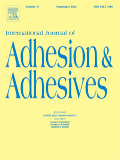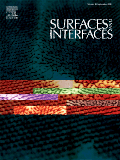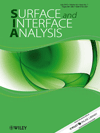
INTERNATIONAL JOURNAL OF ADHESION AND ADHESIVES
Scope & Guideline
Connecting Disciplines through Adhesion Research.
Introduction
Aims and Scopes
- Adhesive Materials Development:
Research on new adhesive formulations, including bio-based, eco-friendly, and high-performance adhesives designed for specific applications in industries such as construction, automotive, and biomedical. - Interfacial Mechanics and Adhesion Science:
Studies that investigate the fundamental mechanisms of adhesion at the molecular and macroscopic levels, including surface treatments, roughness effects, and the role of environmental factors. - Durability and Performance Evaluation:
Assessment of adhesive performance under various conditions, including thermal, moisture, and mechanical stress, to understand long-term durability and reliability. - Innovative Bonding Techniques:
Exploration of novel bonding techniques, such as laser-assisted bonding, hybrid bonding methods, and the use of nanomaterials to enhance adhesion. - Application-Specific Research:
Investigations focusing on specific industries such as dental adhesives, automotive applications, and wood bonding, addressing unique challenges and requirements. - Characterization and Testing of Adhesives:
Development and application of various testing methodologies to characterize adhesive properties, bond strength, and failure modes in different materials and environments.
Trending and Emerging
- Bio-Based and Sustainable Adhesives:
There is a notable increase in research focused on the development of bio-based adhesives derived from natural sources, emphasizing sustainability and reduced environmental impact. - Nanotechnology in Adhesives:
Emerging studies are increasingly exploring the incorporation of nanomaterials into adhesive formulations to enhance properties such as strength, durability, and functionality. - Smart and Responsive Adhesives:
Research on adhesives that respond to environmental stimuli (e.g., temperature, moisture) is on the rise, reflecting the demand for adaptive materials in various applications. - Advanced Characterization Techniques:
The use of advanced characterization methods, such as molecular dynamics simulations and high-resolution imaging techniques, is becoming more prevalent, enabling deeper insights into adhesive behavior. - Multifunctional Adhesives:
There is growing interest in multifunctional adhesives that combine bonding with additional properties, such as antimicrobial, conductive, or self-healing characteristics, catering to specialized applications. - Additive Manufacturing and Adhesion:
Research focusing on adhesion in the context of additive manufacturing is gaining momentum, addressing challenges related to bonding in 3D printed materials.
Declining or Waning
- Conventional Synthetic Adhesives:
Research focused on traditional synthetic adhesives, such as standard epoxy or polyurethane formulations, appears to be waning as the field increasingly shifts towards bio-based and environmentally friendly alternatives. - Generalized Adhesion Theories:
Papers discussing broad, non-specific adhesion theories have decreased, indicating a preference for more application-driven and material-specific studies that address practical challenges. - Adhesive Bonding in Non-Engineering Contexts:
There has been a reduction in studies exploring adhesive bonding in non-engineering contexts, such as household adhesives or low-tech applications, reflecting a more industrial and scientific focus. - Low-Temperature Adhesives:
Research on low-temperature curing adhesives has become less prominent, possibly due to advancements in adhesive technologies that allow for broader application ranges. - Basic Adhesive Chemistry:
While foundational chemistry remains important, the journal has seen a decline in publications that focus solely on basic chemical principles without applications or implications for real-world adhesive performance.
Similar Journals

CRYSTENGCOMM
Advancing crystallization knowledge for a brighter scientific future.CRYSTENGCOMM is a distinguished journal published by the Royal Society of Chemistry, dedicated to advancing the field of crystallization and crystal engineering. With its impact factor consistently among the top tier in its category, CRYSTENGCOMM serves as an essential platform for researchers, professionals, and students in Chemistry, Condensed Matter Physics, and Materials Science. The journal has successfully maintained its relevance and influence since its inception, showcasing pioneering research from 1999 to 2024, with a commendable Q2 ranking in the latest evaluations. This accessibility to crucial developments in crystallization facilitates knowledge transfer across disciplines and enhances collaboration within the scientific community. Although it operates under a subscription model, the journal remains committed to disseminating cutting-edge research and fostering innovation in the field. For more information or to submit your research, please visit the Royal Society of Chemistry's website.

INTERNATIONAL POLYMER PROCESSING
Exploring Innovations in Polymer Processing TechnologiesINTERNATIONAL POLYMER PROCESSING, published by WALTER DE GRUYTER GMBH, serves as a crucial platform for professionals and researchers in the fields of Chemical Engineering, Industrial and Manufacturing Engineering, and Materials Science, particularly focusing on polymers and plastics. With its ISSN 0930-777X and E-ISSN 2195-8602, this journal has been in circulation since 1988 and continues to expand its contributions to contemporary research trends through to 2024. Ranking in the third quartile across multiple categories, including Chemical Engineering (miscellaneous) and Materials Chemistry, it offers insightful and rigorous peer-reviewed articles that enhance the understanding of polymer processing technologies and innovations. This journal is vital for anyone engaged in polymer science and engineering, providing both theoretical and practical perspectives that advance the field. Although it does not provide open access, the journal's content is indispensable for academia and industry professionals looking to stay at the forefront of polymer research.

Surfaces and Interfaces
Innovating Through Interfacial PhenomenaSurfaces and Interfaces is a leading international journal published by Elsevier, dedicated to advancing the understanding of surface and interfacial phenomena across various disciplines, including chemistry, materials science, and physics. With an impressive impact factor placing it in the Q1 quartile for its categories as of 2023—spanning Chemistry, Condensed Matter Physics, and Surfaces, Coatings, and Films—this journal not only serves as a critical platform for innovative research but also reflects the dynamic nature of surface science in contemporary applications. The journal is indexed in Scopus, ranking 25th out of 132 in the Materials Science – Surfaces, Coatings and Films category, marking it in the top 19% of this prestigious field. Although it is not an open-access platform, the journal remains a vital source of curated academic material for researchers, professionals, and students seeking to deepen their knowledge and contribute to ongoing conversations in surface and interface science. Published from the heart of Europe in Amsterdam, Surfaces and Interfaces invites submissions that challenge conventional paradigms and explore the forefront of technology and materials.

Journal of Coatings Technology and Research
Elevating Coatings Research for a Sustainable TomorrowThe Journal of Coatings Technology and Research, published by Springer, stands as a vital resource for researchers and professionals in the fields of materials science and chemistry. With an ISSN of 1547-0091 and an E-ISSN of 1935-3804, this journal is recognized for its significant contributions to the study of coatings technology, encompassing diverse aspects from surfaces and interfaces to colloids and surface chemistry. Currently holding a 2023 Impact Factor that places it in the Q2 and Q3 quartiles across several categories—including Chemistry and Colloid and Surface Chemistry—the journal serves as an essential platform for disseminating innovative research. Its accessibility options cater to a broad audience, ensuring that both established scholars and emerging researchers can engage with the latest findings. Since its inception in 2004, the journal has continued to foster advancements in coatings technologies, promoting sustainable practices and novel applications across industries.

JOURNAL OF ADHESIVE DENTISTRY
Exploring Breakthroughs in Oral Health and Adhesive TechniquesThe Journal of Adhesive Dentistry is a premier publication dedicated to advancing the science and practice of adhesive dentistry, published by Quintessence Publishing Co Inc. Known for its rigorous peer-reviewed research, this journal offers an invaluable resource for researchers, dental professionals, and students engaged in the fields of orthodontics, periodontics, and oral surgery. With a significant impact factor and ranked in the top quartile for its respective categories, the journal consistently publishes high-quality articles that influence clinical practices and innovations. Since becoming an Open Access publication in 2022, it has enhanced global accessibility to groundbreaking research, fostering collaboration and knowledge-sharing across diverse dental disciplines. Covering converged years from 1999 to 2024, the journal remains a vital platform for disseminating critical findings that shape the future of adhesive techniques and oral health outcomes.

Materials Physics and Mechanics
Bridging Physics and Engineering for Material AdvancementMaterials Physics and Mechanics is a pivotal journal dedicated to advancing the fields of condensed matter physics, materials science, mechanical engineering, and the mechanics of materials. Published by the Institute of Problems in Mechanical Engineering, Russian Academy of Sciences, this journal has established itself as a valuable resource since its inception, particularly from 2003 to 2004 and now continuously from 2009 to 2024. Although it currently holds a Q4 categorization in various disciplines, its contributions are critical to understanding and developing new materials and their applications in engineering. The journal provides insightful articles that explore the nuances of material properties, their behaviors under different conditions, and the physical principles governing these phenomena. Though it operates under a traditional publication model, the insights provided within its pages are invaluable to researchers, professionals, and students striving to push the boundaries of knowledge in the materials domain. Its ISSN numbers (1605-2730, E-ISSN 1605-8119) serve as a gateway to a wealth of scientific knowledge emanating from the Russian Federation, contributing to the global discourse in materials physics and mechanics.

Revista Romana de Materiale-Romanian Journal of Materials
Connecting researchers to inspire breakthroughs in materials innovation.The Revista Romana de Materiale, also known as the Romanian Journal of Materials, is a crucial platform for the dissemination of research and innovation within the field of materials science. Published by the SERBAN SOLACOLU FOUNDATION in Romania, this journal has been contributing to the academic community since its inception in 2008, with a focus on a diverse range of topics related to materials science. Despite its current categorization in the Q4 tier and ranking within the 18th percentile according to Scopus, the journal serves an essential role in fostering knowledge sharing and collaboration among researchers, professionals, and students alike. While access options are limited, the journal provides a valuable resource for those interested in the latest developments and advancements in materials science. Located at STR GHEORGHE POLIZU NR 1, COD 011061 SECTOR 1, BUCUREST 00000, ROMANIA, the journal continues to promote academic excellence and foster the growth of this vital field.

SURFACE AND INTERFACE ANALYSIS
Pioneering Research in Nanoscale PhenomenaSURFACE AND INTERFACE ANALYSIS, published by WILEY in the United Kingdom, is a renowned journal specializing in the examination of nanoscale phenomena and the properties of surfaces and interfaces across various materials. With a focus on advancing the fields of Chemistry, Condensed Matter Physics, and Materials Science, this journal has established itself as a critical resource since its inception in 1979, bridging over four decades of scientific discourse. Notably, it holds a commendable position in the Scopus rankings, emerging in the 2023 Q3 quartile across multiple categories, including Chemistry (miscellaneous) and Surfaces, Coatings, and Films. Although it does not currently offer Open Access, SURFACE AND INTERFACE ANALYSIS remains pivotal in disseminating high-quality research, providing an essential platform for academic scholars, industry professionals, and students aiming to deepen their understanding of surface phenomena and material characteristics. Its comprehensive coverage of innovative methodologies, experimental results, and theoretical insights reaffirm its significance in the scientific community.

BioResources
Advancing sustainable solutions through innovative bioresources.BioResources is a pioneering open access journal launched in 2006, dedicated to disseminating knowledge at the intersection of bioengineering, environmental engineering, and waste management. Published by NORTH CAROLINA STATE UNIVERSITY DEPARTMENT OF WOOD & PAPER SCIENCE, this journal serves as a vital platform for researchers and professionals to explore the sustainable use of biomaterials and renewable resources. With an impact reflected through its Scopus rankings, including a respectable position in the 2023 quartile rankings across several relevant categories, BioResources is committed to advancing scientific discourse and enhancing the understanding of bioresource utilization. The journal not only supports high-quality research but also encourages contributions that shape environmental policies and practices. Accessible globally, it invites active participation from scholars aiming to contribute to a more sustainable future. Researchers, professionals, and students alike will find valuable insights and groundbreaking research within its pages as it continues to foster knowledge and innovation in the field.

European Journal of Wood and Wood Products
Shaping the future of wood products through research.The European Journal of Wood and Wood Products, published by Springer, serves as a pivotal platform for scholarly communication within the fields of Forestry and Materials Science. With a proud history that dates back to its initial publication in 1937, this journal has continuously evolved, addressing cutting-edge issues and advancements in wood science and technology. It currently holds a Q2 ranking in both Forestry and Materials Science categories, indicating its significant impact and reputation among researchers, as evidenced by its high rankings in Scopus, where it is placed 27th in Forestry and 167th in General Materials Science. The journal's open access options foster greater dissemination of research findings, supporting the global wood industry and related scientific communities. As it continues to publish high-quality research through 2024, the European Journal of Wood and Wood Products remains an essential resource for those looking to stay at the forefront of wood-related research and innovation.